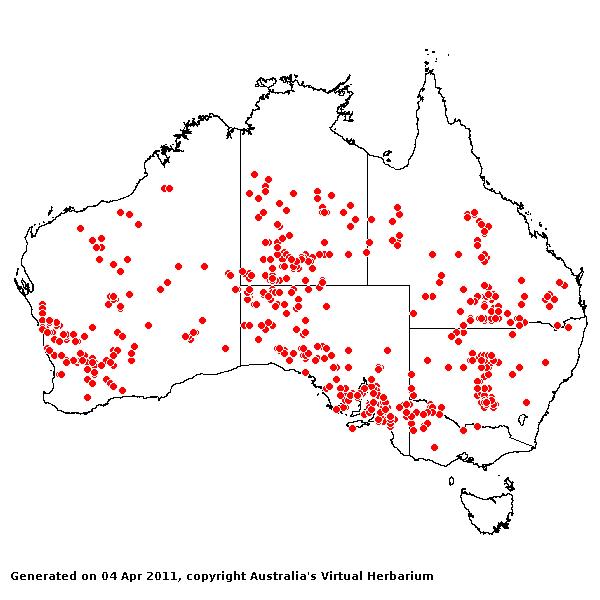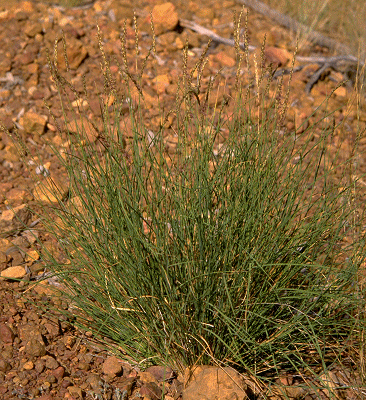Amphipogon caricinus F.Muell. Linnaea
25: 445 (1852).
Classification. (GPWG 2001) : Subfamily
Arundinoideae. Tribe Amphipogoneae.
Type of Basionym or
Protologue Information: LT: Mueller s.n., Nov. 1851, Australia:
South Australia (MEL). LT designated by Vickery, Contr. New South Wales
Herb. 1(5): 289 (1950).
Key references
(books and floras): [1981] M.Lazarides in J.Jessop (ed)., Flora of
Central Australia (447), [2002] D.Sharp & B.K.Simon, AusGrass,
Grasses of Australia, [2006] J.Jessop, G.R.M.Dashorst, F.M.James, Grasses
of South Australia (281), [2008] S.W.L.Jacobs, R.D.B.Walley &
D.J.B.Wheeler, Grasses of New South Wales (120).
Illustrations: [2005]
K.Mallet (ed.), Flora of Australia 44B: Poaceae 3 (Fig 2, A-E as
var. caricinus), [2006] J.Jessop, G.R.M.Dashorst, F.M.James, Grasses
of South Australia (282, Fig. 218 as
var. caricinus), [2008] S.W.L.Jacobs, R.D.B.Whalley & D.J.B.Wheeler,
Grasses of New South Wales, 4th edn (120).
Derivation: L. carex,
reed-grass; -inus, belonging to. Similar to Carex.
Habit.
Perennial. Culms erect, 20–50 cm tall, 4 -noded. Ligule a fringe of hairs.
Leaf-blades convolute, 10–15 cm long, 2–3 mm wide. Leaf-blade surface
scaberulous.
Inflorescence.
Inflorescence solid, a panicle. Panicle oblong, 2–4(–6) cm long.
Spikelets.
Spikelets pedicelled. Basal sterile spikelets absent or rudimentary. Fertile
spikelets 1-flowered, comprising 1 fertile floret(s), without rachilla extension,
oblong, laterally compressed, 6–7 mm long.
Glumes. Glumes
similar, thinner than fertile lemma. Lower glume ovate, chartaceous, without
keels, 3 -nerved. Upper glume ovate, 6–7 mm long, chartaceous, without keels, 3
-nerved. Upper glume surface scabrous.
Florets.
Fertile lemma 5–6 mm long, without keel, 3 -nerved. Lemma surface glabrous or
indumented. Lemma apex lobed, awned, 3 -awned. Median (principal) awn 2.5–3 mm
long overall. Lateral lemma awns present. Palea 2 -nerved, without keels. Palea
apex lobed, awned. Anthers 3.
Continental
Distribution: Australasia.
Australian
Distribution: Western Australia, Northern Territory, South Australia,
Queensland, New South Wales, Victoria.
Western Australia:
Dampier. Giles, Fortescue, Ashburton, Carnarvon, Austin. Irwin, Dale, Menzies,
Eyre, Roe, Avon, Coolgardie. Northern Territory: Victoria River, Barkly
Tableland, Central Australia North, Central Australia South. South Australia:
North-western, Nullabor, Gairdner-Torrens Basin, Flinders Ranges, Eyre Peninsula,
Northern Lofty, Murray, Yorke Peninsula, Southern Lofty, Kangaroo Island,
South-eastern. Queensland: Burke, Burnett, Darling Downs, Gregory North,
Maranoa, Mitchell, North Kennedy, Warrego, South Kennedy. New South Wales:
North-Western Slopes, North-Western Plains, South-Western Plains, North Far
Western Plains, South Far Western Plains. Victoria: Grampians, Murray
Mallee.
Notes.
Infra -specific taxa: var. caricinus, var. scaber.
Lemmas with two
vertical bands of hairs in lower part A. caricinus var. caricinus
Lemmas uniformly hairy
below lobes
Bristles ciliate to
tips A. caricinus var. sericeus
Bristles scabrous A. caricinus var. scaber





